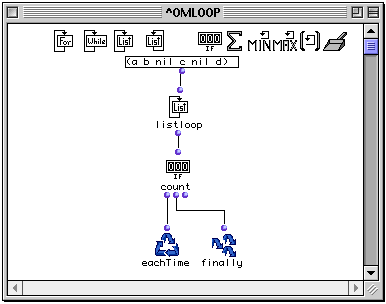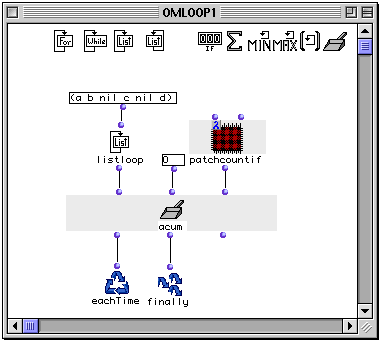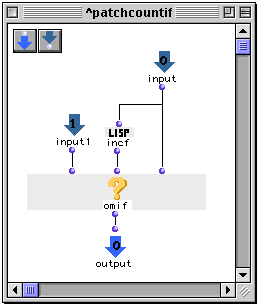OpenMusic Reference
counter (count)

counter (count)
(control module) -- registers the number of times what? has a non-nil value
Syntax
counter what? &optional retard
 |
Though it is called counter in its LISP code, this function appears as count when used inside omloop . The reason eludes me.
—|—
Inputs
| name | data type(s) | comments |
|---|---|---|
| what? | any | |
| retard | a function name or lambda function |
Output
| output | data type(s) | comments |
|---|---|---|
| first | an integer | triggers the collection |
| second | an integer | returns the state of the collection without evaluation |
| third | 0 | reinitializes the counter, resetting it to zero |
Description
 |
counter is part of a group of functions for performing iterative loops. They can only be used within an omloop patch window. Since they only function within the context of the entire repeating loop, they (or any function connected to them) cannot be evaluated directly within the patch window. You must evaluate the entire loop. See the entry on omloop for more information.
—|—
counter is a type of collector. It adds registers the number f times what? has a non-nil value.
Like all collectors, counter has three outputs:
The first output triggers the counter, evaluating whatever is connected to it and causing the counter to increase by 1 if that value is non-nil. It is usually connected to eachTime . The value carried by the connection itself is the current state of the counter, which you can verify by placing the lisp function print between the first output and eachTime .
The second output returns the current state of counter, without evaluating whatever is connected to it. It is usually connected to finally so that you can get the results of the count.
The third output reinitializes the counter, resetting it to zero. The value carried by the connection is always 0.
Examples
 |
About the collectors |
|---|---|
counter is a type of collector. The most generalized type of collector is the function accumulator . Some collectors are special versions of the accumulator function. In these cases, the example of the use of the specific collector is reproduced with accumulator to illustrate this. The reader is therefore advised to read the entry on accumulator before continuing.
Using counter

The list of six values (a b nil c nil d) contains nil twice and non-nil elements four time. listloop will enumerate the values one by one and pass them to counter . Running this loop will cause counter to report:
? OM->4
Reproducing counter with accumulator

We will set up accumulator to perform exactly the same function. The listloop output of (a b nil c nil d) is run into the first input. We set the initial value to zero and connect a special lambda patch to the fun input. It is this custom-made patch that will do the work of counter . It has the following internal structure:

The elements sent by listloop are at input 1. They are connected right to omif , which will use the LISP function incf to add one to the internal state of the collector (coming into input zero) every time a non-nil element is received. The two nil elements of the list cause input zero to be passed without changing it, and the stored result will thus not be incremented.
| Prev | Home | Next |
|---|---|---|
| onlistloop | Up | sum |